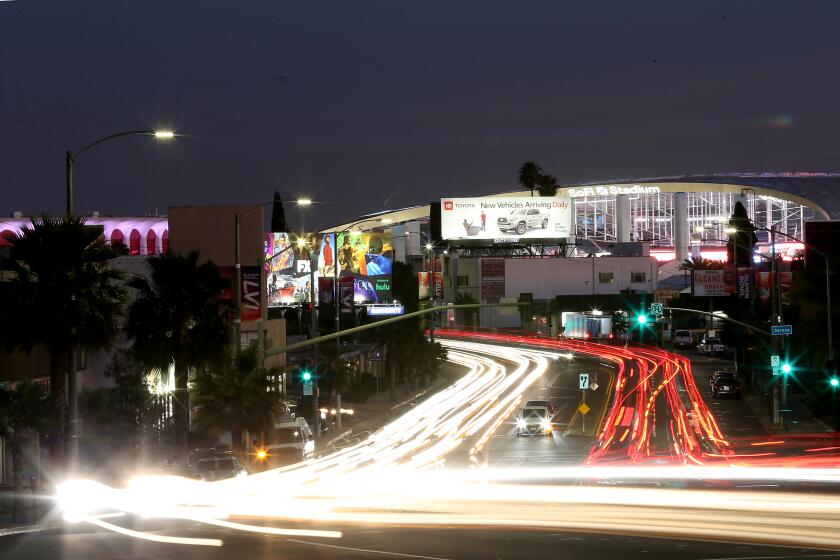California wants to reduce traffic. The Newsom administration thinks AI can help

Being stuck in traffic is a familiar problem for many Californians, but state officials want to harness the power of artificial intelligence to discover new solutions.
The California Department of Transportation, teaming up with other state agencies, is asking technology companies by Jan. 25 to propose generative AI tools that could help California reduce traffic and make roads safer, especially for pedestrians, cyclists and scooter riders. Generative AI tools such as ChatGPT can quickly produce text, images and other content, but the technology can also help workers brainstorm ideas.
The request shows how California is trying to tap into AI to improve government services at a time when lawmakers seek to safeguard against the technology’s potential risks. As Microsoft-backed OpenAI, Google and other tech giants roll out new AI-powered tools, the technology’s rapid pace of advancement has raised concerns about misinformation, job displacement, copyright infringement and privacy.
California politicians set the stage for more AI regulation in 2024, but they’ll also face challenges as they try to place more guardrails around AI’s impact on jobs, safety and discrimination.
The state’s plan to potentially use artificial intelligence to help alleviate traffic jams stems from an executive order that Gov. Gavin Newsom signed in September about generative AI. As part of the order, the state also released a report outlining the benefits and risks of using AI in state government.
California state agencies have access to a trove of valuable data, including from thousands of traffic sensors and cameras. Analyzing that data to quickly reduce traffic and improve safety can be challenging. The huge volume of data comes in various forms, such as photos, videos and text.
The state currently uses technology to help analyze traffic data, but the agencies rely heavily on workers to decide what to do to improve the flow of traffic in real time. Generative AI could come up with better solutions.
“It probably would change the strategy much, much faster than a human being will be able to do,” said Amy Tong, secretary of government operations for California.
There are many reasons why traffic jams happen, including crashes, debris in the roadway, major events that draw big crowds and bad weather. But there are also recurring issues that can make roads more congested, said California Secretary of Transportation Toks Omishakin.
For example, a narrow part of a road could hinder the flow of traffic. Workers could use generative AI to brainstorm solutions.
“There’s potential for generative AI to actually help us better funnel traffic through those areas, instead of automatically thinking ‘Oh, let’s just widen the road. That’s the solution,’” he said.
Caltrans also wants to use generative AI to help achieve its vision of having zero road fatalities and serious injuries by 2050. Through analysis of crash sites, lighting conditions, traffic patterns and behavior of “vulnerable roadway users” such as pedestrians and cyclists, Caltrans says AI could help workers identify areas that are at higher risk for accidents and suggest safety measures.
“This proactive approach will enable transportation system operators and engineers to anticipate and address safety issues in advance or more quickly, rather than merely reacting to them after the fact,” a document outlining the problem Caltrans is trying to solve states.
As technology becomes more incorporated in state government work, Omishakin said he anticipates jobs will change but not be entirely replaced.
Companies are already using AI to analyze traffic patterns and the movement of people on the roads, including drivers and bicyclists. Google, for example, has a research initiative known as Project Green Light that cities such as Seattle are participating in that aims to improve the flow of traffic and reduce greenhouse gas emissions from cars on the road. As part of the project, Google uses AI to identify when engineers can adjust the timing of traffic lights and provides those recommendations to city officials.
INRIX, a transportation analytics company, announced a new generative AI-powered product in November that could help cities better manage the flow of traffic. A report by the company found that Los Angeles in 2022 was the 6th-most congested city in the United States with delays costing drivers, on average, 95 lost hours and $1,601.
Technology also isn’t perfect and humans need to be in the mix to ensure that the AI system is using data from the right sources and not spewing out errors, Tong said. The state is also taking steps to limit potential data security and privacy issues. State data that vendors use in the AI systems have to be stored within Caltrans’ “managed cloud environments,” according to a document about the state proposal.
The state’s request for innovative ideas involves various steps that include the state evaluating the solutions the companies suggest. California, which faces a record $68-billion budget deficit, may then award a contract to companies. Other state agencies are also planning to ask businesses to provide ideas to help improve other state services, including call centers that help taxpayers, Tong said.
“We definitely have the budget constraint in mind, but at the same time, public safety is a high priority for the administration,” Tong said. “So that’s why we continue to explore these options.”
More to Read
Sign up for Essential California
The most important California stories and recommendations in your inbox every morning.
You may occasionally receive promotional content from the Los Angeles Times.








